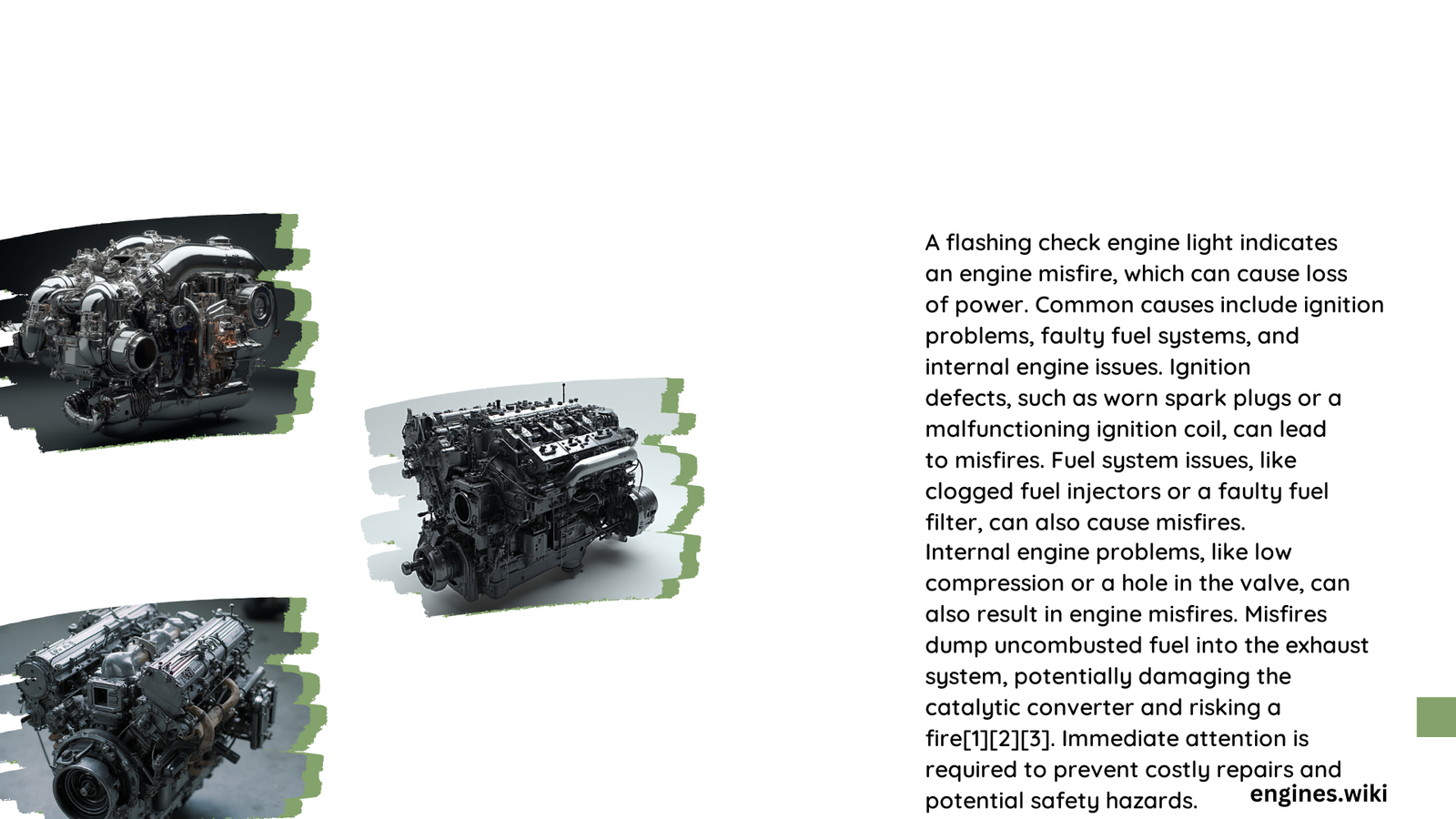A flashing check engine light accompanied by a loss of power is a serious issue that requires immediate attention. This combination often indicates engine misfires, which can lead to severe damage if not addressed promptly. Common causes include ignition system failures, fuel delivery problems, and sensor malfunctions. Immediate action is crucial to prevent further damage and ensure safe vehicle operation.
What Are the Common Causes of a Flashing Check Engine Light and Power Loss?
The most frequent causes of a flashing check engine light and power loss include:
- Ignition system malfunctions
- Fuel delivery issues
- Sensor failures
- Internal engine problems
Let’s explore each of these in detail:
1. Ignition System Malfunctions
- Spark Plug Issues: Worn or fouled spark plugs can cause misfires.
- Ignition Coil Problems: Faulty coils can lead to incomplete combustion.
2. Fuel Delivery Issues
- Fuel Injector Problems: Clogged injectors can disrupt fuel flow.
- Fuel Pump Failure: A weak pump can cause insufficient fuel delivery.
3. Sensor Failures
- Oxygen Sensor Malfunction: Can lead to incorrect air-fuel mixture.
- Mass Airflow Sensor Issues: May cause improper fuel metering.
4. Internal Engine Problems
- Low Compression: Can result from worn piston rings or valve issues.
- Timing Chain Problems: May cause engine misfires and power loss.
What Diagnostic Trouble Codes Are Associated with This Issue?

When experiencing a flashing check engine light and power loss, you may encounter the following Diagnostic Trouble Codes (DTCs):
| DTC Range | Description |
|---|---|
| P0300-P0308 | Random or specific cylinder misfire |
| P0171-P0175 | Fuel system too lean or too rich |
| P0420-P0430 | Catalytic converter efficiency below threshold |
| P0440-P0457 | Evaporative emission control system malfunction |
These codes provide valuable information for diagnosing the root cause of the problem.
How Can I Diagnose the Problem at Home?
While professional diagnosis is recommended, you can perform some initial checks:
- Use an OBD-II scanner to retrieve trouble codes.
- Inspect spark plugs for wear or damage.
- Check for loose or damaged ignition coils.
- Listen for unusual engine noises.
- Look for visible fuel leaks or damaged fuel lines.
What Are the Immediate Steps to Take When the Check Engine Light Starts Flashing?
When your check engine light starts flashing and you experience power loss:
- Reduce speed immediately.
- Pull over to a safe location as soon as possible.
- Turn off the engine to prevent further damage.
- Do not attempt to restart the vehicle until it’s been inspected.
- Call for a tow truck to transport the vehicle to a repair shop.
How Much Does It Cost to Fix This Issue?
The cost to repair a flashing check engine light and power loss issue varies depending on the root cause:
- Spark plug replacement: $100-$300
- Ignition coil replacement: $100-$300 per coil
- Fuel injector cleaning or replacement: $200-$500 per injector
- Oxygen sensor replacement: $200-$500
- Major engine repairs: $1,000-$5,000+
Always get a detailed diagnosis and estimate before proceeding with repairs.
Can I Drive with a Flashing Check Engine Light and Power Loss?
No, it is not safe or recommended to drive with a flashing check engine light and power loss. Continuing to drive can cause:
- Severe engine damage
- Catalytic converter failure
- Increased risk of accidents due to unpredictable performance
- Potential for complete engine failure while driving
Always prioritize safety and have your vehicle towed to a repair shop for immediate inspection.
How Can I Prevent This Issue in the Future?
To minimize the risk of experiencing a flashing check engine light and power loss:
- Follow your vehicle’s recommended maintenance schedule.
- Use high-quality fuel and oil.
- Address minor issues promptly before they escalate.
- Have regular tune-ups performed by a qualified mechanic.
- Pay attention to any changes in your vehicle’s performance.
By staying proactive with maintenance, you can often avoid serious engine problems and the associated costs.
What Are the Long-Term Consequences of Ignoring This Problem?
Ignoring a flashing check engine light and power loss can lead to:
- Catastrophic engine failure
- Expensive repairs or engine replacement
- Increased emissions and environmental impact
- Reduced vehicle resale value
- Potential safety hazards while driving
It’s crucial to address this issue immediately to avoid these severe consequences.
Remember, a flashing check engine light combined with power loss is a serious warning sign that should never be ignored. Prompt action and professional diagnosis are key to preventing extensive damage and ensuring your vehicle’s longevity and safety.
